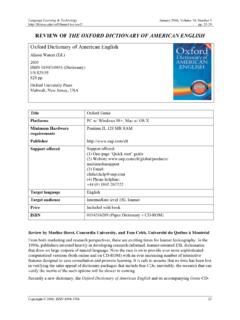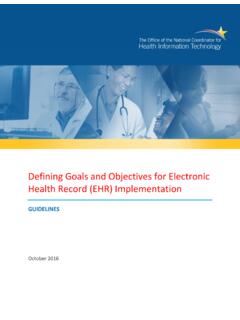Transcription of Key Performance Indicators across the Perioperative …
1 Proceedings of the 50th Hawaii International Conference on System Sciences | 2017. Key Performance Indicators across the Perioperative Process: Holistic Opportunities for Improvement via Business Process Management Jim Ryan Barbara Doster Auburn University at Montgomery University of Alabama-Birmingham Hospital Sandra Daily Carmen Lewis Cullman Regional Medical Center Troy University Abstract entire Perioperative process can identify and ultimately This study examines the development and use achieve continuous improvement via business process of multiple scorecard metrics within each stage of the management (BPM). Perioperative process as key Performance Indicators to A hospital's Perioperative process is complex [12], enable business process management practices across involving multiple interconnected sub-processes that the entire process to target and measure continuous provide surgical care for inpatients and outpatients improvement.
2 This paper identifies how dynamic during pre-assessment, pre-operative, intra-operative, technological activities of analysis, evaluation, and and post-operative activities. Furthermore, the synthesis applied to internal and external organizational Perioperative process yields patient end-state goals data can highlight complex relationships within where: (1) a correct diagnosis for surgical intervention is integrated hospital processes to target opportunities for identified with noted co-morbidities and patient consent;. improvement and ultimately yield improved process (2) a patient undergoes the surgical procedure; (3) a capabilities. The identification of existing limitations, patient exhibits minimal exacerbation of existing potential capabilities, and the subsequent contextual disorders; (4) a patient avoids new morbidities; and (5) a understanding are contributing factors that yield patient experiences prompt procedure recovery [28].
3 Measured improvement. This case study investigates the Meeting Perioperative patient end-state goals will also impact of integrated information systems to identify, avoid hospital-acquired-conditions (HACs) [6] and qualify, and quantify Perioperative improvement based hospital-acquired-infections connected with negative on a 154-month longitudinal study of a large, financial incentives [23, 33]. However, Perioperative registered-bed teaching hospital. The theoretical and sub-processes ( pre-assessment, pre-operative, intra- practical implications and/or limitations of this study's operative, post-operative, and ancillary central sterile results are also discussed with respect to practitioners supply activities) are sequential, where activity sequence and researchers alike. paces the efficiency and effectiveness of subsequent activities which can risk achievement of patient end-state 1.
4 Introduction goals. Consequently, the Perioperative process is tightly coupled to patient safety, patient quality of care, patient The current focus of healthcare administration in the flow, and stakeholders' satisfaction ( patient, United States has shifted toward Performance monitoring physician/surgeon, nurse, Perioperative staff, and and improving clinical outcomes to meet regulatory and hospital administration). reimbursement requirements due to the American This case study identifies complex Perioperative Recovery and Reinvestment Act of 2009, the Health dynamics within and across the entire process that are Information Technology for Economic and Clinical nested in the hospital environment and reflected via sub- Health Act, the Affordable Care Act, and the Joint process scorecard metrics.
5 This research investigates Commission on Accreditation of Healthcare how traditional business process management (BPM). Organizations (TJC) / Centers for Medicare & Medicaid practices are applicable to explain Perioperative Services (CMS) core measures [4]. Meeting these complexity and measure continuous process Performance and reporting challenges requires improvement. This study specifically highlights multiple leveraging information systems (IS) and technologies scorecard metrics from each Perioperative sub-process (IT) [26]. Consequently, the widespread IS/IT adoption ( pre-assessment, pre-operative, intra-operative, post- across healthcare also necessitates the need for value operative, and ancillary central sterile supply activities). realization [14]. To this end, this study investigates how and demonstrates how the metrics are applicable as key key Performance Indicators (KPIs) across a hospital's Performance Indicators (KPIs) and how each Perioperative sub-process supports specific patient end- URI: ISBN: 978-0-9981331-0-2.
6 CC-BY-NC-ND 3479. state goals. The investigation method covers a quality of care and patient safety, coupled with increased longitudinal study of an integrated clinical scheduling efficiency and cost effectiveness. Measured utilization of information system (CSIS) within an academic medical these practices is not a result from any lack of research center. The implementation of agile, integrated as an extensive body of knowledge exists concerning the information systems (IS) and subsequent contextual application of these approaches in healthcare [2, 7, 10, understanding of Perioperative sub-process data and 30]. However, the literature suggests that such prescribed opportunities for measured improvements. management practices and interventions can yield Specifically, developing and implementing Perioperative positive results with significant variations in sub-process metrics as KPIs, grounded in internal and implementation success.
7 External best-practices, provides the framework for targeting opportunities and evoking improvement. The Business Process Management (BPM). combined assessment of sub-process KPIs also provide change dynamics for evaluation and improvement to the Continuous process improvement (CPI) is a overall Perioperative process. systematic approach toward understanding process The following sections review previous literature on capability, customer's needs, and sources of observed BPM, KPIs, as well as Perioperative scorecards and variation. Tenner and DeToro [29] views CPI as an dashboards. Following the literature review, we present organizational response to an acute crisis, a chronic our methodology, case study background, observed problem, and/or an internal driver. CPI encourages effects and summary discussion.
8 By identifying a bottom-up communication at the day-to-day operations holistic framework for analysis, evaluation, and level and requires process data comparisons to control synthesis of end-to-end process measures with metrics. Incremental improvement gains occur via established benchmarks, this paper prescribes an a priori iterative cycles of analysis, evaluation, and synthesis or environment to support effective and efficient plan-do-study-act [32] to minimize observed variation. Perioperative sub-process improvement by addressing Doubt can exist as to: whether the incremental sub-process root causes rather than process symptoms. improvement addresses symptoms versus causes;. The conclusion also addresses study implications and whether the improvement effort is sustainable year after limitations.
9 Year; and/or whether management is in control of the process [13]. 2. Literature Review This study uses the BPM definition provided by Jeston and Nelis [13, p. 10] as the achievement of an Integrated information systems (IS) offer continuity organization's objectives through the improvement, through information sharing, synergy, and improvement management, and control of essential business [18]. Likewise, integrated IS and IT provide processes. The authors further elaborate that process measurement and subsequent accountability for management and analysis is integral to BPM, where healthcare quality and cost, creating a dichotomy ( , there is no finish line for improvement. Hence, this study quality versus cost) that represents the foundation for views BPM as an organizational commitment to healthcare improvement [8].
10 Within the Perioperative consistent and iterative business process Performance process, patient end-state goals are the focus of work. improvement that meets organizational objectives. However, United States hospitals currently face Business analytics is the body of knowledge identified increasing pressure to provide objective evidence of with technology solutions that incorporate Performance organizational quality, efficiency, and effectiveness [4, management, definition and delivery of business metrics, 35]. To this end, a BPM approach [13, 32] borrowed as well as data visualization and data mining [31]. from the manufacturing industry provides a framework Business analytics within BPM focus on the effective to target and measure improvement. use of organizational data and information to drive The Perioperative process is typically the primary positive business action [29].














